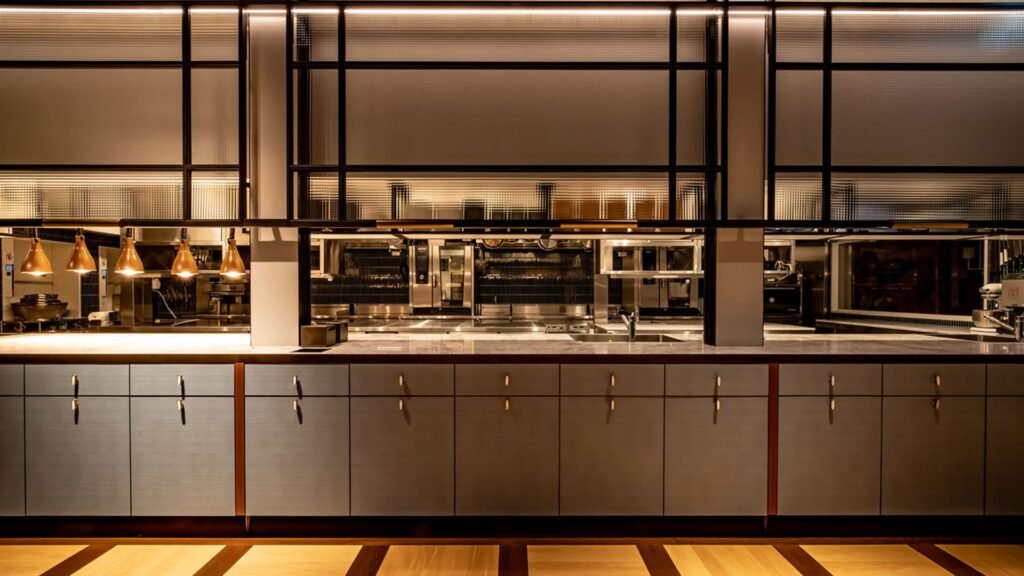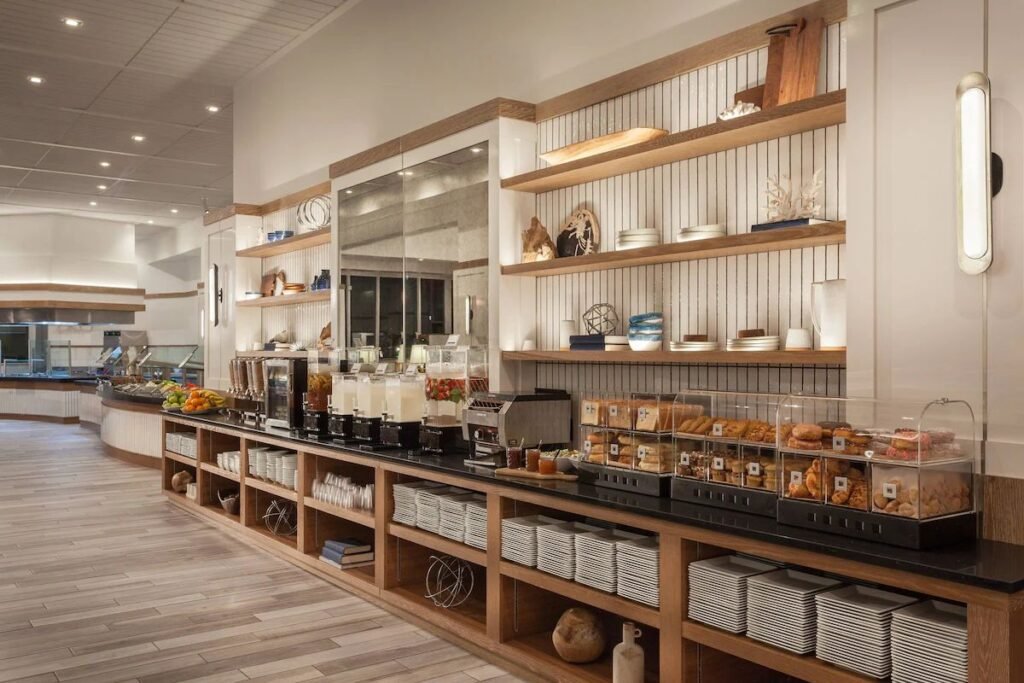Meta Description:
Discover how expertly designed food service stations transform industrial kitchens and canteens into efficient, stylish production and assembly areas with luxury designer touches.

Introduction
Food service stations are the unsung heroes of industrial kitchens and canteens, playing a pivotal role in ensuring smooth operations and exceptional dining experiences. Whether it’s a bustling corporate cafeteria or a large-scale food production area, these stations act as the heartbeat of efficiency and style. For luxury interiors, marrying functionality with sophisticated design is essential — the right food service stations can seamlessly blend utility with elegance, creating spaces that look as impressive as they perform. In this post, Good House Interiors explores innovative ideas and expert tips to transform your food service stations into stunning focal points within commercial kitchen design and employee dining facilities.
The Importance of Food Service Stations in Industrial Kitchens and Canteens
Food service stations are more than just counters or serving areas. They are carefully crafted hubs designed to streamline workflow, manage traffic flow, and elevate the dining environment. In industrial kitchens and canteens, these stations must be designed with an acute understanding of space optimization and hygiene, without sacrificing aesthetic appeal. A well-planned food service station not only enhances operational efficiency but also reflects a brand’s commitment to quality and care.
Key Elements of Exceptional Food Service Stations
1. Thoughtful Space Planning
The foundation of any great food service station lies in intelligent cafeteria layouts. The station must fit naturally within the flow of the kitchen and dining space, minimizing congestion while maximizing accessibility. Designing with a focus on production and assembly areas helps ensure that ingredients and dishes move smoothly from preparation to plate.
2. Durable Materials with Designer Touches
In industrial kitchens and canteens, durability is non-negotiable. Surfaces must withstand constant use, cleaning, and occasional spills. However, this doesn’t mean compromising on luxury. Incorporating refined materials such as polished stainless steel with warm wood accents or textured stone can introduce subtle designer touches that elevate the entire space.
3. Multi-functional Zones
Food service stations often serve several purposes: from meal distribution to payment processing and even food customization areas. Designing these zones thoughtfully helps improve service speed and customer satisfaction. Modular designs with adjustable components can allow flexibility and future scalability.
Innovative Design Ideas for Food Service Stations
Integrate Technology for Seamless Service
Modern food service stations benefit hugely from technology integration. Think touchless payment systems, digital menu boards, and temperature-controlled serving areas that maintain food quality while streamlining operations. These tech-savvy touches not only boost efficiency but also add a contemporary edge to the space.
Focus on Lighting and Ambiance
Lighting is an often overlooked yet critical design element in employee dining facilities. Illuminating food service stations with a mix of task lighting and ambient lighting can highlight fresh ingredients, make food choices more enticing, and create a welcoming atmosphere. Designer pendant lights or sleek LED strips can serve as both functional fixtures and aesthetic statements.
Customize with Bespoke Furniture
Luxury interiors thrive on bespoke elements. Custom-designed counters, integrated shelving, and seating options tailored to the specific needs of your canteen space add a layer of sophistication and exclusivity. Good House Interiors specializes in creating custom furniture that complements the industrial robustness of kitchens while enhancing comfort and style.
Best Practices for Designing Food Service Stations in Industrial Settings
- Prioritize Hygiene: Select materials and finishes that are easy to clean and resistant to bacteria. Seamless surfaces and integrated sinks can simplify sanitation routines.
- Plan for Accessibility: Ensure stations are accessible to all employees and guests, including those with disabilities, to foster inclusivity and compliance with regulations.
- Optimize Workflow: Analyze traffic patterns and food preparation flow to position stations logically, reducing bottlenecks and wait times.
- Incorporate Branding: Use colors, textures, and signage that reflect your brand identity, subtly reinforcing company values and culture.
Conclusion
In the world of industrial kitchens and canteens, food service stations are vital both operationally and visually. With the right blend of space planning, durable yet elegant materials, and thoughtful designer touches, these stations can transform a utilitarian necessity into a luxurious feature. Good House Interiors invites you to explore our bespoke solutions—from space planning to custom furniture—that bring sophistication and efficiency to your commercial kitchen design and employee dining facilities. Contact us today to elevate your food service environment with expert craftsmanship and timeless style.
FAQ
Q1: What makes a food service station effective in industrial kitchens and canteens?
A1: An effective food service station combines efficient workflow design, durable materials, hygiene-friendly surfaces, and ergonomic layouts to ensure smooth food distribution and employee satisfaction.
Q2: How can technology improve food service stations?
A2: Technology like digital menu boards, touchless payment, and temperature-controlled serving areas streamlines operations, reduces wait times, and maintains food quality.
Q3: What are key considerations for hygiene in food service station design?
A3: Choosing non-porous, easy-to-clean materials, seamless surfaces, and incorporating sinks or sanitizing stations helps maintain strict hygiene standards.
Q4: How do custom furniture and designer touches impact food service stations?
A4: Custom furniture adds exclusivity and functionality tailored to your space, while designer touches enhance the aesthetic appeal, creating an inviting dining atmosphere.
Q5: Can food service stations be adapted for future changes?
A5: Yes, modular designs with flexible components allow food service stations to evolve with operational needs and trends, ensuring longevity and adaptability.

محطات تقديم الطعام: رفع مستوى المطابخ الصناعية والكانتينات بلمسات تصميم فاخرة
تُعد محطات تقديم الطعام الأبطال المجهولين في المطابخ الصناعية والكانتينات، حيث تلعب دورًا محوريًا في ضمان سير العمليات بسلاسة وتقديم تجربة طعام استثنائية. سواء كنت تدير كافتيريا شركات مزدحمة أو منطقة إنتاج طعام على نطاق واسع، فإن هذه المحطات تمثل القلب النابض للكفاءة والأناقة. في عالم التصميم الداخلي الفاخر، يُعد التوازن بين الوظيفة والجمال ضرورة—فالمحطة المصممة بعناية يمكن أن تدمج العملية والانسيابية مع الأناقة والرقي، لتصبح عنصرًا بصريًا جذابًا داخل تصميم المطبخ التجاري. في هذه التدوينة، تقدم لكم Good House Interiors أفكارًا مبتكرة ونصائح احترافية لتحويل محطات تقديم الطعام إلى نقاط محورية رائعة ضمن مرافق الطعام المؤسسية.
أهمية محطات تقديم الطعام في المطابخ الصناعية والكانتينات
محطات تقديم الطعام ليست مجرد طاولات أو مناطق توزيع. إنها نقاط استراتيجية مصممة بعناية لتسهيل سير العمل، وتنظيم حركة المرور، ورفع مستوى بيئة تناول الطعام. في المطابخ الصناعية والكانتينات، يجب تصميم هذه المحطات بعين خبيرة توازن بين تحسين استخدام المساحة والحفاظ على أعلى معايير النظافة—دون التضحية بالأناقة. فالتخطيط الجيد لمحطة تقديم الطعام لا يُحسن الكفاءة التشغيلية فحسب، بل يعكس أيضًا التزام المؤسسة بالجودة والاهتمام بالتفاصيل.
العناصر الأساسية لمحطات تقديم طعام استثنائية
1. تخطيط ذكي للمساحة
الأساس في أي محطة تقديم طعام متميزة هو تخطيط منطقي في تصميم الكافيتيريا. يجب أن تندمج المحطة بسلاسة ضمن تدفق الحركة في المطبخ ومنطقة تناول الطعام، لتقليل الازدحام وتحقيق أقصى استفادة من المساحة. ويساهم التركيز على مناطق الإنتاج والتجميع في ضمان انتقال الأطعمة والمكونات بسهولة من التحضير إلى التقديم.
2. مواد متينة بلمسات تصميم فاخرة
في بيئات المطابخ الصناعية والكانتينات، يجب أن تتحمل المواد ظروف الاستخدام المكثف والتنظيف المتكرر. ومع ذلك، لا يعني ذلك التضحية بالفخامة. يمكن دمج الفولاذ المقاوم للصدأ المصقول مع لمسات من الخشب الدافئ أو الحجر المزخرف لإضفاء لمسات تصميم راقية تضيف بعدًا بصريًا فاخرًا.
3. مناطق متعددة الوظائف
غالبًا ما تؤدي محطات تقديم الطعام عدة وظائف—من توزيع الوجبات إلى معالجة المدفوعات أو حتى تخصيص الطلبات. يساهم التصميم الذكي لهذه المناطق في تحسين سرعة الخدمة ورضا الموظفين. وتعد التصاميم المعيارية ذات المكونات القابلة للتعديل مثالية للمرونة وتوسعة المحطة مستقبلًا.
أفكار تصميم مبتكرة لمحطات تقديم الطعام
دمج التكنولوجيا لخدمة سلسة
تستفيد محطات تقديم الطعام الحديثة من إدماج التكنولوجيا، مثل أنظمة الدفع دون لمس، الشاشات الرقمية للوجبات، والمناطق المزودة بالتحكم في درجة الحرارة لحفظ جودة الطعام. تعزز هذه الابتكارات الكفاءة وتضيف طابعًا عصريًا للمكان.
التركيز على الإضاءة والأجواء
الإضاءة عنصر حاسم في تصميم مرافق الطعام للموظفين. الإضاءة المناسبة—سواء كانت إضاءة عملية أو محيطة—تُبرز الطعام، وتُضفي دفئًا، وتُحسن تجربة تناول الطعام. يمكن للإضاءة المعلقة المصممة خصيصًا أو مصابيح LED الحديثة أن تضيف لمسة تصميمية بارزة.
تفصيل الأثاث حسب الطلب
التصميمات الفاخرة تتطلب عناصر مخصصة. توفر Good House Interiors أثاثًا مصممًا حسب الطلب لمحطات تقديم الطعام—بدءًا من الطاولات المدمجة، وأرفف التخزين، وصولًا إلى وحدات الجلوس—والذي يجمع بين الأداء العالي والجاذبية البصرية الفائقة.
أفضل الممارسات في تصميم محطات تقديم الطعام ضمن البيئات الصناعية
- إعطاء الأولوية للنظافة: اختيار مواد سهلة التنظيف ومقاومة للبكتيريا، مع أسطح ملساء وأحواض مدمجة لتبسيط عمليات التنظيف.
- التخطيط لسهولة الوصول: التأكد من أن المحطة مناسبة للجميع، بما في ذلك ذوي الاحتياجات الخاصة، لتحقيق بيئة شاملة ومتوافقة مع المعايير.
- تحسين سير العمل: تحليل تدفق حركة العمل والطهي لتحديد أماكن المحطات المناسبة لتقليل الازدحام والانتظار.
- دمج الهوية البصرية: استخدام الألوان والمواد والعلامات التجارية لتعزيز هوية المؤسسة وجعل المكان أكثر ارتباطًا بالعلامة.
الخاتمة
في عالم المطابخ الصناعية والكانتينات، تُعد محطات تقديم الطعام عناصر محورية من حيث التشغيل والتصميم. من خلال التخطيط الذكي، المواد المتينة، والتفاصيل المصممة بعناية، يمكن تحويل هذه المحطات إلى نقاط جذب بصرية عالية الأداء. تقدم Good House Interiors حلولاً مخصصة—من تخطيط المساحات إلى تصميم الأثاث—لتحقيق التوازن بين الكفاءة والأناقة. تواصل معنا اليوم لاكتشاف كيف يمكننا تحويل بيئة تقديم الطعام لديك إلى تجربة فاخرة وعملية.
الأسئلة الشائعة
ما الذي يجعل محطة تقديم الطعام فعالة في المطابخ الصناعية والكانتينات؟
محطة تقديم فعالة تتميز بتصميم يحقق تدفقًا سلسًا، مواد متينة، مساحات صحية، وتوزيع منطقي يُسهل عملية التقديم ويزيد رضا المستخدم.
كيف تُساهم التكنولوجيا في تحسين محطات تقديم الطعام؟
التقنيات الحديثة مثل الدفع الذكي، شاشات العرض، والمناطق المنظمة حراريًا تُسرّع العمليات وتحسن جودة الخدمة.
ما أهم الاعتبارات الصحية عند تصميم محطة تقديم الطعام؟
اختيار أسطح غير مسامية، سهلة التنظيف، مع تصميم خالٍ من الزوايا الحادة ومناطق تراكم البكتيريا يُعد أساسيًا للحفاظ على بيئة صحية.
ما دور الأثاث المخصص واللمسات الفاخرة؟
الأثاث المصمم حسب الطلب يعزز الوظيفة ويمنح هوية فريدة، بينما تضيف اللمسات الفاخرة بعدًا جماليًا يميز المكان.
هل يمكن تعديل محطات تقديم الطعام مستقبلًا؟
نعم، يمكن تصميم المحطات بشكل معياري ومرن لتسهيل تطويرها وتوسيعها حسب الحاجة مع تغير احتياجات التشغيل.
